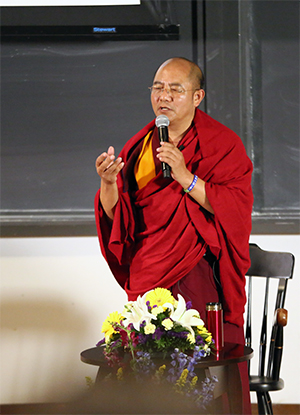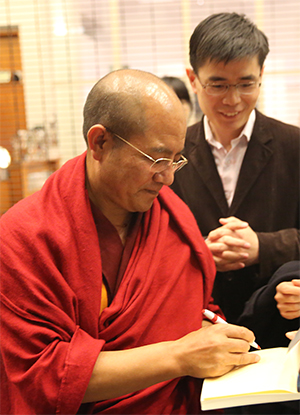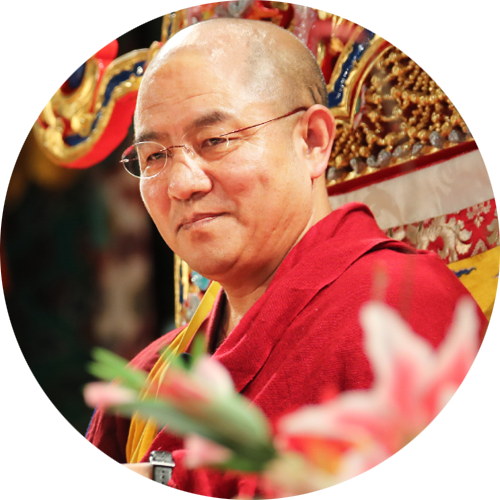Bodhisattva’s Path — The Practice and Action in the Modern Society
Khenpo Sodargye shows a bracelet with logos of different religions and goes on to expound the harmony of the teachings of Mahayana Buddhism with that of other religions and secular society. What is Mahayana Buddhism? How to practice it? In this talk, Khenpo Sodargye teaches how to study, reflect and practice Mahayana Buddhism.
What Makes Mahayana Buddhism Different from Other Religions?
What Makes Mahayana Buddhism Different from Other Religions?
Yesterday, when we went to Yale, the staff from Religious Department gave me a bracelet with different religious symbols. I think it’s a good thing. I’m respectful of and am keen to learn all religions.
As a Buddhist, I am devoted to studying and practicing the Dharma. It’s my duty to promote Dharma teachings without causing conflicts with other religions. The main subject of today’s teaching is Mahayana bodhicitta. Working for the benefit of all sentient beings is the primary goal of Mahayana Buddhism — and this goal is the distinctive feature separating it from other schools of religion.
Those who can arouse the supreme bodhicitta are Mahayana Buddhists. Those who only care for their own liberation from the samsara, or for the happiness, health and avoidance of pain in the present lives are not Mahayana Buddhists. Religious sects are differentiated on the basis of their aspirations as each aspiration leads to a distinct result.
Relative and Absolute Bodhicitta
There are two kinds of bodhicittas—the relative and the absolute. Absolute bodhicitta is a direct insight into the absolute nature of things. It is very difficult for ordinary people to arouse absolute bodhicitta.
Everyone can arouse relative bodhicitta in their minds. Relative bodhicitta is further divided into two types, i.e., bodhicitta in aspiration and bodhicitta in action. Bodhicitta in aspiration is the real desire to pursue the Bodhisattva path for the sake of all living beings, while bodhicitta in action is the actual practice on the path, i.e., endeavoring to take actions to benefit of others within one’s ability.
The Essence of Dharma Teachings
I feel happy whenever I meet an altruistic person. I would also have confidence in that person. The world is full of selfish people. Very few people would give up their own self-interest in order to benefit others. It’s very rare to see people with altruism.
To develop and maintain bodhicitta, we need to learn and observe many Bodhisattva vows and precepts. But the fundamental precept is not to harm other beings. It’s not only the essential teachings of Mahayana, but also the essence of all Dharma teachings.
Einstein’s View of Being a Vegetarian
Einstein said, “Although I have been prevented by outward circumstances from observing a strictly vegetarian diet, I have long been an adherent to the cause in principle. Besides agreeing with the aims of vegetarianism for aesthetic and moral reasons, it is my view that a vegetarian manner of living by its purely physical effect on the human temperament would most beneficially influence the lot of mankind”. This was the first time he had ever talked about vegetarianism. He also said, “I have always eaten animal flesh with a somewhat guilty conscience”. Then in the following years, he gradually reduced the consumption of meat.
When Einstein was about to leave the world, he mentioned in a letter to his friend, “So I am living without fats, without meat, without fish, but am feeling quite well this way. It always seems to me that man was not born to be a carnivore”.
Three Degrees of Courage for Arousing Bodhicitta
There are three types of bodhicitta commitments that a bodhisattva can undertake. The first one is the shepherd’s way of arousing bodhicitta: the wish to lead sentient beings to Buddhahood first before attaining Buddhahood for self, just like a shepherd following and looking after his flock of sheep. The second is the boatman’s way of arousing bodhicitta: the wish to achieve Buddhahood for oneself and all beings at the same time, like arriving on the other shore together on the same boat. The third one is the king’s way of arousing bodhicitta: the wish first to attain Buddhahood for oneself and then to bring others to Buddhahood.
The shepherd’s way, called “the arousing of bodhicitta beyond compare”, is the most sublime of all. Bodhisattvas Manjushri and Ksitigarbha are said to have aroused bodhicitta in this way.

Relative and Absolute Bodhicitta
Everyone can arouse relative bodhicitta in their minds. Relative bodhicitta is further divided into two types, i.e., bodhicitta in aspiration and bodhicitta in action. Bodhicitta in aspiration is the real desire to pursue the bodhisattva path for the sake of all living beings, while bodhicitta in action is the actual practice on the path, i.e., endeavoring to take actions to benefit of others within one’s ability.

The Essence of Dharma Teachings
To develop and maintain bodhicitta, we need to learn and observe many Bodhisattva vows and precepts. But the fundamental precept is not to harm other beings. It’s not only the essential teachings of Mahayana, but also the essence of all Dharma teachings.
“Although various rituals are performed in Buddhist practices, these rituals are not core teachings of Buddhism. The core of Buddhism is altruism and bodhicitta.”
















